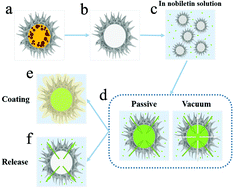Leveraging plant exine capsules as pH-responsive delivery vehicles for hydrophobic nutraceutical encapsulation
Abstract
Plant exine capsules are natural microscale capsules that are highly physically robust and chemically resilient. They are extracted from pollen grains and plant spores, and can be used as renewable and safe microcapsules for encapsulation applications. Herein, we report the successful evacuation of natural sunflower pollen grains (SPGs) and Lycopodiastrum casuarinoides spore exine capsules (SECs) and investigated the effects of different loading methods on the encapsulation and release of nobiletin, a model hydrophobic nutraceutical. The compositional and morphological characterizations of SPGs and SECs obtained by the developed extraction protocol confirmed that the inside contents had been removed and hollow pollen cavities were obtained successfully. In addition, coumarin-6, a hydrophobic fluorescent probe, was encapsulated into SPGs and SECs, which proved the possibility of using them to encapsulate hydrophobic nutraceuticals. Furthermore, controlled release in simulated digestive fluids (SDF) was achieved by coating calcium alginate onto the outside of the SPGs and SECs. Looking forward, this may provide an effective and potential delivery model to protect loads from degradation in the stomach and achieve pH-responsive delivery of hydrophobic nutraceuticals after oral administration.



 Please wait while we load your content...
Please wait while we load your content...